
|
|||
|---|---|---|---|
|
|
Evaluation of sleep, rest and the relationship of consumption of nutrients hormone modulators in academy professionals Avaliação do sono, descanso e a relação do consumo de nutrientes moduladores hormonais em profissionais de uma academia Evaluación del sueño, descanso y relación del consumo de nutrientes moduladores hormonales en profesionales de un gimnasio |
|
|
|
*Acadêmica do Curso de Nutrição da Universidade do Vale do Itajaí, UNIVALI/SC **Nutricionista. Doutoranda em Ciências Farmacêuticas; Mestre em Nutrição Docente do Centro de Ciências da Saúde da UNIVALI/SC ***Nutricionista. Especialista em Nutrição Clinica e Nutrição Esportiva Funcional Academia Wave – Barra Norte/SC |
Camile Cecconi Cechinel* Luciane Angela Nottar Nesello** Maria Barboza*** (Brasil) |
|
|
|
Abstract The circadian cycle controls the rhythm of metabolism, acting on growth, maturation, energy balance, appetite, and overall health. This study aimed to evaluate sleep, rest, and the ratio of consumption of hormone modulators nutrients in a professional gym. The participants filled an adapted semi-structured questionnaire containing questions of identification, anthropometry, exercises, sleep, rest, pain and injury. To assess the relationship of the variables with the nutrients ingested by them, it was applied the 24h recall. Data on food consumption were calculated in Avanutri® Software version 4.0. Descriptive analysis was performed with mean and standard deviations of variables. 18 people were interviewed, 72% (n = 13) teachers of bodybuilding and fitness, most males 61% (n = 12), with a mean age of 29.5 years. The average BMI found was 24.22 kg/m2. Most respondents reported no insomnia (50%) and cramp (82%). In relation to food intake, carbohydrate had inadequacy for less at 83% of respondents, followed by protein with 72%, and of these, 44% had excess. Participants had low intakes of micronutrients sleep-related hormone modulators, especially vitamin C and D with 94% of inadequacy and B complex vitamins, calcium, magnesium, potassium and fiber 100%. Sleep and nutrition are fundamental to the proper functioning of the body, but in athletes, they work in the prevention of injuries, fatigue and improving performance. Excess protein consumption and low-carbohydrate and micronutrients were observed among fitness professionals. It’s important to fitness professionals the knowledge about the importance of sleep and food, not only in the performance thereof, but on health, quality of life and disease prevention. Keywords: Sleep. Nutrients. Hormones. Gyms.
Resumo O ciclo circadiano cronometra os ritmos do metabolismo, atuando no crescimento, maturação, balanço energético, apetite e saúde em geral. Objetivou-se avaliar o sono, descanso e a relação do consumo de nutrientes moduladores hormonais em profissionais de uma academia. Os indivíduos responderam um questionário semi-estruturado adaptado contendo questões de identificação, antropometria, aulas e exercícios praticados, sono, descanso, dores e lesões. Para avaliar a relação dos nutrientes ingeridos, foi aplicado o Recordatório 24h. Os dados do consumo alimentar foram calculados no Software Avanutri® versão 4.0. Foi realizada análise descritiva apresentando médias e desvios-padrão das variáveis. Foram entrevistadas 18 pessoas, sendo 72% professores de musculação e ginástica, a maioria do gênero masculino 61%, com média de idade de 29,5 anos. Apresentando IMC médio de 24,22 kg/m2. A maior parte dos entrevistados relatou não ter insônia (50%) e câimbras (82%). Em relação ao consumo alimentar o carboidrato apresentou inadequação para menos em 83% dos entrevistados, seguido pela proteína com 72%, sendo que destes, 44% apresentou excesso. Os participantes apresentaram baixa ingestão de micronutrientes moduladores hormonais relacionados ao sono, destacando-se vitamina C e D com 94% de inadequação e vitaminas do Complexo B, cálcio, magnésio, potássio e fibras com 100%. Conclui-se que o sono juntamente com a nutrição são fundamentais para o bom funcionamento do corpo, porém, em atletas atuam também na prevenção de lesões, fadiga e melhora do rendimento. Ressalta-se a importância do conhecimento aos profissionais de academia e praticantes de atividade física para a saúde, qualidade de vida e prevenção de doenças. Unitermos: Sono. Nutrientes. Hormônios. Academias de ginástica.
|
|||
|
|
EFDeportes.com, Revista Digital. Buenos Aires, Año 19, Nº 196, Septiembre de 2014. http://www.efdeportes.com/ |
|
|
1 / 1
Introduction
The circadian cycle occurs through a timing system in an organized manner that regulates the daily rhythms about behavior, physiology and metabolism of the body. It is synchronized according to environmental changes such as light/dark cycle, and thereby coordinates the rhythmic activities of innumerable subordinate clocks in virtually all tissues and organs of the body (SILVER; KRIEGSFELD, 2014).
Throughout the day, the body undergoes stress changes in demand, and in order to maintain the biological processes regulated and physiologically well-functioning, mechanisms are working on adapting to these ripples. Homeostasis is influenced by endocrine factors in the regulation of both oscillations along 24h, as with responsiveness of target tissues for these signals or stimuli. These daily oscillations occur as endocrine response to behavioral fluctuations associated with sleep, wake, fasting and feeding cycles, being regulated by the circadian clock (GAMBLE et al., 2014).
Sleep has importance on factors such as growth, maturation, energy balance, appetite, and overall health. Sleep deprivation and its relationship to overweight and obesity occur through biological mechanisms, such as the roles exercised by leptin, ghrelin, insulin, cortisol and growth hormone, because changes in their concentrations can promote weight gain (BOUKHRIS; BRAGANÇA, 2012).
In physically active people, the role of sleep is no different, it is essential so that the full potential of the individual is reached, because sleep deprivation negatively influences performance on several levels, as in decreased motor capacity, increasing the chance of injuries, slowness in movement and falling energy reserves. Also generates changes in mood, tiredness and anxiety. When there is a sleep deficit, decreases in exercise tolerance and injury can occur with a much lower load training (SOARES, 2011).
The hormones play important roles, such as the high levels of cortisol that can lead to muscle atrophy and reduced strength, reducing the performance of the exercise by stimulating proteolysis. With physical exercise the body becomes less responsive to stress, which brings beneficial effects on physical and mental health, protecting him from the consequences of chronic stress and related diseases (BUENO; GOUVÊA, 2011). Gamble et al. (2014), mentions that morbidities such as metabolic syndrome and cancer are also precipitated by the irregularity of the circadian cycle, by means of genetic and environmental factors. According to Smith (2011), sleep should be part of the training of sportsmen and athletes plan, like any other component of fitness.
The present study aimed to evaluate sleep, rest, and the ratio of consumption of hormonal modulators nutrients in a professional gym.
Methods
This research is characterized as transversal descriptive, made with academy health professionals in south of Brazil.
The study subjects were selected by the load intense of activity, with fitness and bodybuilding teachers and physical therapists. It was conducted in June 2014, after everyone had agreed to participate in the study voluntarily.
A semi-structured questionnaire adapted from Million and Hidalgo (2013) with open and closed questions on identification, anthropometry and questions about lessons and exercises practiced, sleep, rest, pain and injury was applied.
Anthropometric data were self referred, and weight and height were used to calculate the Body Mass Index (BMI), classified by the Protocol of the Ministry of Health (BRAZIL, 2008).
It was also applied a food survey named Recall 24h (R24h) for food intake a day of participants in order to relate the variables with the nutrients ingested.
The R24h was calculated in Avanutri ® Software version 4.0. The energy requirements of professionals were estimated from EER (NATIONAL ACADEMY OF SCIENCES, 2008) with moderate activity factor. The need of macronutrients was based on the guidelines of the Brazilian Society of Sports Medicine (SBME, 2009), and the adequacy of micronutrients was calculated individually according to the Recommended Daily Amount (RDA) for gender and age (NATIONAL ACADEMY OF SCIENCES 2011, 2011).
The data relating to the questionnaire and dietary intake was tabulated in Microsoft Office Excel 2007. To describe quantitative variables it was calculated the mean and standard deviation, minimum and maximum. Categorical variables were description through their absolute frequencies (n) and relative (%).
Results and discussion
18 professionals from a gym were interviewed, 61% (n = 12) were male and 39% (n = 7) respondents were female, with mean age of 29.5 years (5.85), ranging between 21:46 year old. Had an average of 6.82h (3.76) of work per day. Of research subjects, 72% (n = 13) were teachers and 28% (n = 5) interns and physiotherapists, with an average BMI of 24.22 kg/m2 (2.63), and 44% (n = 8) were considered overweight and 56% (n = 10) as eutrophic (BRAZIL, 2008).
Although in the present study, the percentage of normal weight and overweight have been similar, unlike what Coelho et al. (2009) when evaluated professional athletes in table tennis, basketball, karate and volleyball, and all had the BMI between 20 and 25, featuring the entire group as eutrophic. However, Ribeiro et al. (2002) states that isolated measures in athletes or sportsmen is not enough to know the true condition of them, being necessary addition to weight and height, skinfold measurements.
When asked about sleep, the average hours that the respondents slept were 6.07 hours (0.95). Ribeiro and Magalhães (2012) found similar results when evaluated sleep quality of 230 athletes from different sports, noting that the average sleep per night of them was 7 hours and 38 minutes.
In the present study, the time that the subjects reported that they would choose to wake up to perform their activities, taking only the personal well being into consideration, it was 08:30 (1.05), and to go to bed, 23:30 (1.00), totaling approximately 9 hours of sleep, three more hours than the usual amount.
Long term changes in sleep time may affect the gastrointestinal tract function and absorption of energy. This decrease of rest plays a significant role in the emergence of diseases because it creates insulin resistance and increases blood pressure, with the possibility of leading to future diseases (MOTA; SANTOS, 2010). The poor quality of sleep also contributes to the development of immunological and mental problems such as depression, anxiety and stress (RIBEIRO; MAGALHÃES, 2012).
Sleep deprivation can also decrease the concentrations of hormones such as testosterone, however, along with dietary restrictions, may result in increased of serum concentrations of progesterone, and can still produce changes in sexual response (ALVARENGA; TUKIF; ANDERSEN, 2008). The decrease in testosterone levels is related to increased body fat, reduced bone and muscle mass, fatigue, depression and loss of libido (SHIPS, 2010).
Still on the sleep of the participants, as shown in Table 1, it is observed that most consider to be fairly easy to wake up, do not feel stressed waking up, do not suffers from insomnia and has no interrupted sleep.
Table 1. Sleep-related character from professionals of an academy in southern Brazil
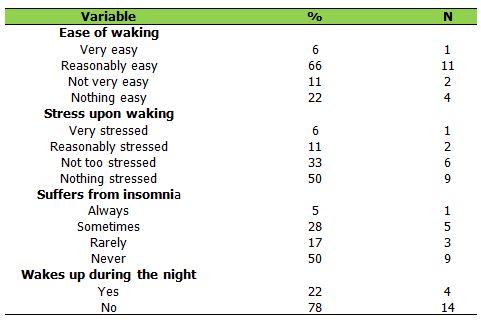
Table 2 shows the responses of the interviewees in relation to fatigue, sleep and injuries. It appears that the majority (39%) reported having very good appetite on waking. Many teachers do not feel very tired throughout the day (44%), and the greatest moment of exhaustion of them is in the evening (67%). The best moment of well-being was reported in the afternoon (56%), followed by the morning (44%). A smaller part had lesions in the past six months and the vast majority reported never feels cramps (82%).
Although only 33% of respondents had lesions, according to Barroso and Thiele (2011), lesions are among the most common orthopedic complaints and occur in both athletes and non-athletes. Corroborating with this finding, Rodrigues-Junior and Silva (2014) found a prevalence of 89% of injuries in practicing jiu-jitsu and Gayardo, Matana and Silva (2012) found that among 135 athletes of the National League Futsal, 54.10 % presented lesions.
The injury prevention should be made through the muscle strengthening and stretching. However, inadequate nutrition is among the main factors for the onset of injury and nutritional counseling is of paramount importance in the treatment and prevention (SARAGIOTTO; PIERRO; LOPES, 2014). It also highlights that stretching exercises, or use of magnesium or vitamin B (12) are suggestions for the improvement of cramps, mainly nocturnal (ALLEN; KIRBY, 2012).
Table 2. Information relating to fatigue, injury and cramps of the teachers interviewed
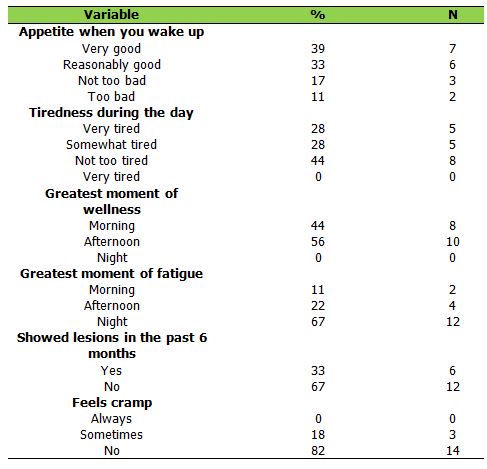
The data on the dietary habits of individuals (Table 3) show that half of the respondents had the habit of snacking between meals (50%) considered their eating healthy, but about what could change for better, reported the reduction of quantity of intakes (39%). Also stated in its majority (83%) the desire to eat candy.
Corroborating with this study, in relation to the consumption of sweets, Couto et al. (2014), in a study with 1233 adolescents about the 10 steps to a healthy diet, observed that the decrease in consumption of sweets and goodies showed the lowest frequency, as only 1.60% of respondents were able to achieve this goal. In addition, taking into account also the consumption of these foods, Zanini et al. (2013) observed that 40% of 624 students surveyed reported having the habit of consuming sweets every day. Zart (2010) points out that high consumption of high sugar and fat foods occurs primarily by factors such as practicality found in fast foods, less time for preparation and ease of acquisition.
The brain is responsible for controlling feeding behavior and appetite, and for this, some hormones are essential, such as insulin. But beyond the fundamental role of insulin in regulating blood glucose concentrations, it also acts on receptors found on hypothalamus's cells, considered the "command center", influencing in feelings of hunger, greediness, excess weight and satiety (KONNER; BRÜNING, 2011).
Table 3. Data on dietary habits of the subjects in this study
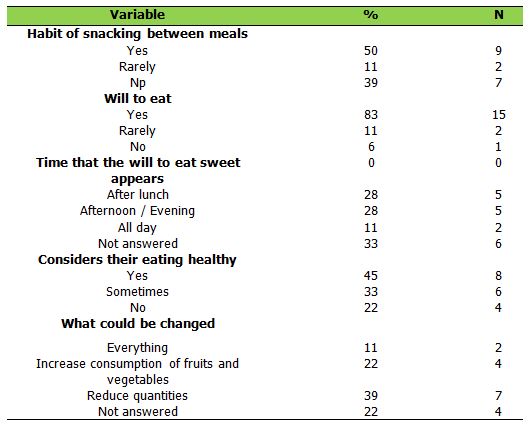
Regarding dietary intake of the participants, it was observed that among the macronutrients (Table 4), carbohydrate had the highest percentage of inadequacy, followed by protein. It is noteworthy that within the inadequacy of protein, excess prevailed in 44% of respondents. Coelho et al. (2009) and Schneider (2014) found similar results in studies with athletes and physical education professionals, highlighting the high protein intake at the expense of carbohydrates, surpassing the recommendations. Carbohydrate is the main source of energy, and its deficit is correlated with impairments in performance as early fatigue and prolonged post-training (SCHNEIDER, 2014) recovery.
The consumption of carbohydrates and proteins are efficient to stimulate anabolism, being instrumental in providing a favorable hormonal environment in the processes of re-synthesis of glycogen and protein synthesis (KATER et al., 2011). However, individuals should be aware that increasing protein intake beyond the recommended levels does not lead to further increase in lean mass, because there is a limit to the accumulation of proteins in several tissues (SBME, 2009).
In the present study, the values for vitamins and minerals (Tables 4 and 5) were below the recommendation in the majority, especially vitamin B complex, vitamin C, vitamin D, calcium, magnesium and potassium. In addition, Reis et al. (2011) evaluated the inadequacy of micronutrient intake in women with regular physical activity and also found that the higher prevalence of inadequacy was folic acid (98%), magnesium (86.47), zinc (51.60%) and B6 (43.05%). These data corroborate those found by Coelho et al. (2009) and Schneider (2014), where it was observed low intake of fruits, vegetables, and micronutrient deficits, which are related to the triggering of associated pathologies such as anemia, premature fatigue and increased risk of injury.
Table 4. Consumption and adequacy of macronutrients and vitamins from teachers of an academy in southern Brazil
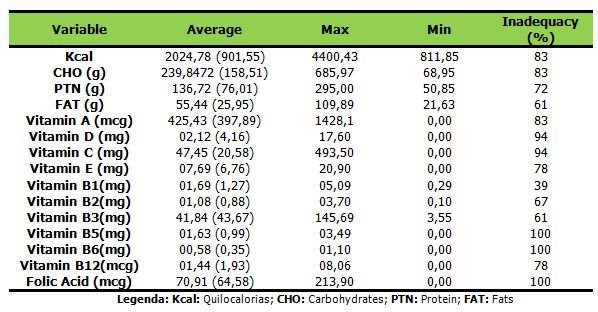
The results are troubling, because the micronutrients prevent oxidative stress and the inflammatory process triggered by exercise. The action of free radicals can result in tissue damage or producing of toxic or harmful compounds to tissues (SILVA et al., 2012) which can lead to cancer, cardiovascular disease and osteoporosis (REIS et al., 2011).
Still, nutritional interventions can act on neurotransmitters associated with sleep, including serotonin, melanin, norepinephrine and histamine. Carbohydrates, tryptophan, melatonin and other substances are possible sleep inducers, becoming promising potential interventions (HALSON, 2014). In addition to regulating sleep, serotonin, is involved in appetite, body temperature, anxiety, learning and memory and also serves as a precursor of melatonin, which works on control mechanisms of the circadian rhythm, sleep-wake cycle and modulation of immune response. These hormones can be leveraged through micronutrients like magnesium, B vitamins, vitamin C, calcium and zinc, essential for this synthesis (SHIP, 2010).
Table 5. Minerals consumption and adequacy of teachers from an academy in southern Brazil
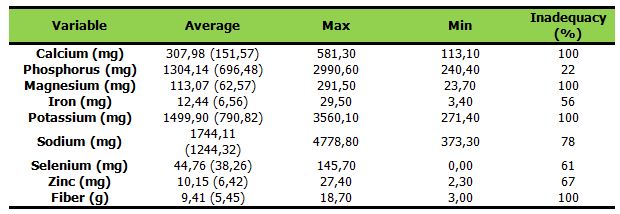
According to Grandner et al. (2014), in addition to the quantity, quality of sleep is also influenced by nutrients. The selenium, calcium and lycopene act facilitating sleep. A low intake of vitamin C is associated to non-restorative sleep. Vitamin D is associated with greater ease in maintaining sleep and potassium with decreased daytime sleepiness.
In the present study, the amount of fiber intake was also inadequate in 100%. According to Sandri, Bernardi and Siviero (2012), the fibers are important and act preventing constipation, promoting better blood glucose control and cholesterol and reduce risk of certain cancers. According to Naves (2010), approximately 90% of serotonin is found in the gastrointestinal tract, because the reflections of intestinal propulsion are stimulated by serotonin. If the intestine is not functioning well, there is no proper serotonin production, which may lead to the consequences previously mentioned.
Conclusions
In conclusion, sleep has a primary role in many body functions, influencing metabolism, physiology, behavior, and overall health. Deprivation leads to consequences and in athletes may contribute to the appearance of injuries and lower yield.
It was found that most respondents were eutrophic, but a large percentage were overweight, however, it is important that to know the real condition of individuals practicing physical activity, calculate the percentage of body fat is important, but was not possible in this study, representing a limitation.
Excess of protein and low-carbohydrate and micronutrients such as vitamins C and D, Complex B, calcium, magnesium, and potassium was observed in this research. It is important to note that nutrition plays an important role in hormone regulation and physical activity, and some nutrients act in modulating of rest and are essential for good performance, preventing injuries, cramps, improving the performance of individuals and sleep.
It is stressed the importance of knowledge by academy professionals and practitioners of physical activity on the importance of sleep and food not only in the performance thereof, but on health, quality of life and disease prevention.
References
-
ALLEN, R. E.; KIRBY, K. A. Nocturnal leg cramps. Am Fam Physician., v. 86, n. 4, p. 350-355. Aug., 2012.
-
ALVARENGA, T. A. F.; TUFIK, S.; ANDERSEN, M. L. Influência da restrição alimentar associada ou não a privação de sono paradoxal na arquitetura de sono e comportamento sexual de ratos machos. 154 f. 2008. Tese (Mestrado em Ciências) – Escolha Paulista de Medicina, Universidade Federal de São Paulo, São Paulo, 2008.
-
BARROSO, G. C.; THIELE, E. S. Lesão muscular nos atletas. Rev. Bras. Ortop., v.46, n.4, p. 355-358, 2011.
-
BOUKHRIS, C.; BRAGANÇA, M. Sobre a relação entre privação de sono e obesidade em crianças e adolescentes: revisão crítica da evidência clínica. 64 f. 2012. Dissertação (Mestrado em Medicina, Ciências da Saúde – Universidade da Beira Interior, Covilhã, 2012.
-
BRASIL. Ministério da Saúde. Protocolos do Sistema de Vigilância Alimentar e Nutricional – SISVAN na assistência à saúde. Série B. Textos Básicos de Saúde. Brasília, 2008.
-
BUENO, J. R.; GOUVÊA, C. M. C. P. Cortisol e exercício: efeitos, secreção e metabolismo. RBPFEX,São Paulo, v.5, n.29, p.435-445. Set/Out., 2011.
-
COELHO, B.; AZEREDO, C.; BRESSAN, E.; GANDELINI, J. GERBELLI, N.; CAVIGNATO, P. Perfil nutricional e análise comparativa dos hábitos alimentares e estado nutricional de atletas profissionais de basquete, karatê, tênis de mesa e voleibol. RBNE, São Paulo. v. 3. n. 18. p. 570-577. Nov/Dez. 2009.
-
COUTO, S. F.; MADRUGA, A.; NEUTZLING, M. B.; SILVA, M. C. Frequência de adesão aos “10 Passos para uma Alimentação Saudável” em escolares adolescentes. Ciência & Saúde Coletiva, v. 19, n. 5, p. 1589-1599, 2014.
-
GAMBLE, K. L.; BERRY, R.; FRANK, S. J.; YOUNG, M. E. Circadian clock control of endocrine factors. Nat Rev Endocrinol, [Epub ahead of print] May, 2014.
-
GAYARDO, A.; MATANA, S. B.; SILVA, M. R.Prevalência de lesões em atletas do futsal feminino brasileiro: um estudo retrospectivo. Rev. Bras. Med. Esporte, v. 18, n. 3, p. 186-189, Maio./Jun., 2012.
-
GRANDNER, M. A.; JACKSON, N.; GERSTNER, J. R.; KNUTSON, K. L. Sleep symptoms associated with intake of specific dietary nutrients. J Sleep Res, v. 23, p. 22-34, 2014.
-
HALSON, S. L. Sleep in elite athletes and nutritional interventions to enhance sleep.Sports Med, v. 44, n. 1, p. 13-23, May, 2014.
-
KATER, D. P.; PIRES, A. B.; LIMA, M. C. S.; GARCIA-JÚNIOR, J. R. Anabolismo pós-exercício: influência do consumo de carboidratos e proteínas. Colloquium Vitae, v. 3, n. 2, p. 34-43, Jul./Dez., 2011.
-
KÖNNER, C.; BRÜNING, J. Hungry for rewards: insulin in the midbrain influences eating behaviour. Max-Planck-Gesellschaft, Jun., 2011. Disponível em: http://www.mpg.de/4338096/insulin_eating_behaviour. Acesso em: 03 Jul 2014.
-
MILHÃO, D. A.; HIDALGO, M. P. L. Comparação do efeito do turno de atividade física no consumo alimentar de esportistas. 45f. 2013. Dissertação (Mestrado em Ciências Médicas – Faculdade de Medicina, Universidade Federal do Rio Grande do Sul, 2013.
-
MOTA, D. P. N.; SANTOS, J. A. Importância dos ritmos circadianos na Nutrição e Metabolismo. 57 f. 2010. Monografia – Faculdade de Ciências da Nutrição e Alimentação, Universidade do Porto, Porto, 2010.
-
NATIONAL ACADEMY OF SCIENCES. DIETARY REFERENCE INTAKES - DRI. Dietary Reference Intakes: RDA and AI for Vitamins and Elements. 2011. Disponível em: http://fnic.nal.usda.gov/dietary-guidance/dietary-reference-intakes/dri-tables. Acesso em: 05 jul. 2014.
-
NATIONAL ACADEMY OF SCIENCES. DIETARY REFERENCE INTAKES - DRI. Dietary Reference Intakes: Recommended Intakes for Individuals. 2011. Disponível em: http://fnic.nal.usda.gov/dietary-guidance/dietary-reference-intakes/dri-tables. Acesso em: 05 jul. 2014.
-
NATIONAL ACADEMY OF SCIENCES. DIETARY REFERENCE INTAKES - DRI. Dietary Reference Intakes for Energy, Carbohydrate, Fiber, Fat, Fatty Acids, Cholesterol, Protein, and Amino Acids (Macronutrients). 2002a. Disponível em: http://www.nap.edu/html. Acesso em: 28 jan. 2008.
-
NAVES, A. Nutrição Clínica Funcional: Modulação Hormonal. VP Editora: São Paulo, 2010.
-
REIS, B. Z.; TEIXEIRA, P. D. S.; COSTA, D.; VIEIRA, D. A. S.; COSTA, J. O.; MENDES- NETO, J. V. F. P.; Prevalência de ingestão inadequada de micronutrientes de mulheres participantes de um programa de atividade física regular. Nutrire, v. 36, supl., p.125-125, 2011.
-
RIBEIRO, C. S. M.; MAGALHÃES, C. M. V. Avaliação da qualidade do sono em praticantes de atividade física em diversas modalidades. 50f. 2012. Dissertação (Mestrado Integrado em Medicina) - Instituto de Ciências Biomédicas Abel Salazar, Universidade do Porto, Porto, 2012.
-
RIBEIRO, J. D.; RIBEIRO, M. A. G. O.; RIBEIRO, A. F. Controvérsias na fibrose cística – do pediatra ao especialista. J. Pediatr., v. 78, supl. 2, p. 171-186, 2002.
-
RORIGUES-JÚNIOR, N. S.; SILVA, N. C. R. A Ocorrência de Lesões na Prática de Jiu-Jitsu em Academias de Floriano-PI. UNOPAR Cient Ciênc Biol Saúde, v. 16, n. 1, p. 25-28, 2014.
-
SANDRI, R.; BERNARDI, J. R.; SIVIERO, J. Consumo de fibras e líquidos em mulheres participantes de uma universidade da terceira idade no Sul do Brasil. RBCEH, Passo Fundo, v. 9, n. 2, p. 213-225, Maio/Ago., 2012.
-
SARAGIOTTO, B. T.; PIERRO, C. D.; LOPES, A. D. Fatores de risco e prevenção de lesões em atletas de elite: estudo descritivo da opinião de fisioterapeutas, médicos e treinadores. Braz J Phys Ther., v. 18, n. 2, p. 137-143, Mar./Abr., 2014.
-
SBME - SOCIEDADE BRASILEIRA DE MEDICINA DO ESPORTE. Modificações dietéticas, reposição hídrica, suplementos alimentares e drogas: comprovação de ação ergogênica e potenciais riscos para a saúde. Rev. Bras. Med Esporte, supl., v. 15, n. 3, p. 3-12, Mar./Abr., 2009.
-
SCHNEIDER, L.; BENNEMANN, G. D.; BALLARD, C. R. TRINDADE, M. C. C. Avaliação de conhecimentos em nutrição e de hábitos alimentares por profissionais educadores físicos no município de Guarapuava – Paraná. RBNE, São Paulo, v. 8, n. 43, p.65-73, Jan/Fev., 2014.
-
SILVA, J. V. F. P.; MOREIRA, S. L. N.; OLIVEIRA, D. C.; SANTOS, T. R.; PADILHA, H. G.; STULBACH, T. et al. Avaliação do consumo de nutrientes antioxidantes por mulheres fisicamente ativas. Brazilian Journal of Sports Nutrition, v. 1, n. 1, p. 30-36, Mar. 2012.
-
SILVER, R.; KRIEGSFELD, L. J. Circadian rhythms have broad implications for understanding brain and behavior. Eur J Neurosci., [Epub ahead of print], May, 2014.
-
SOARES, M. J. R. C. Influência da qualidade do sono na performance dos atletas de alta competição. 20f. 2011. Dissertação (Mestrado em Medicina Integrada) - Instituto de Ciências Biomédicas de Abel Salazar, Universidade do Porto, 2011.
-
ZANINI, R. V.; MUNIZ, L. C.; SCHNEIDER, B. C.; TASSITANO, R. M.; FEITOSA, W. M. N.; GONZÁLEZ-CHICA, D. A.Consumo diário de refrigerantes, doces e frituras em adolescentes do Nordeste brasileiro. Ciência & Saúde Coletiva, v. 18, n. 12, p. 3739-3750, 2013.
-
ZART, V. B.; AERTS, D.; ROSA, C.; BÉRIA, J. U.; RAYMANN, B. W.; GIGANTE, L. F. Cuidados alimentares e Fatores associados em Canoas, RS, Brasil. Epidemiol. Serv. Saúde, Brasília, v.19, n.2, p.143-154, abr./jun., 2010.
Another articles in English
 |

Búsqueda personalizada
|
|---|---|
|
EFDeportes.com, Revista
Digital · Año 19 · N° 196 | Buenos Aires,
Septiembre de 2014 |
|